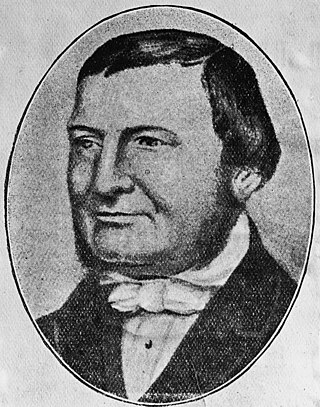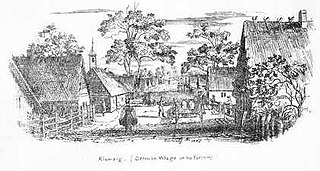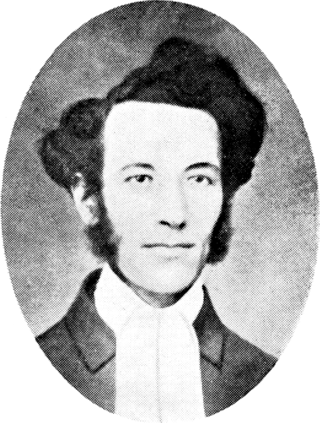
The Lutheran Church – Missouri Synod (LCMS), also known as the Missouri Synod, is an orthodox, traditional, confessional Lutheran denomination in the United States. With 1.7 million members as of 2022 it is the second-largest Lutheran body in the United States, behind the Evangelical Lutheran Church in America. The LCMS was organized in 1847 at a meeting in Chicago, as the German Evangelical Lutheran Synod of Missouri, Ohio, and Other States, a name which partially reflected the geographic locations of the founding congregations.
The Evangelical Lutheran Church in America (ELCA) is a mainline Protestant Lutheran church headquartered in Chicago, Illinois. The ELCA was officially formed on January 1, 1988, by the merging of three Lutheran church bodies. As of 2022, it has approximately 2.9 million baptized members in 8,640 congregations.
Confessional Lutheranism is a name used by Lutherans to designate those who believe in the doctrines taught in the Book of Concord of 1580 in their entirety. Confessional Lutherans maintain that faithfulness to the Book of Concord, which is a summary of the teachings found in Scripture, requires attention to how that faith is actually being preached, taught, and put into practice. Confessional Lutherans believe that this is a vital part of their identity as Lutherans.

Tanunda is a town situated in the Barossa Valley region of South Australia. In the 2021 census, Tanunda recorded a population of 4,710 people.

Hahndorf is a small town in the Adelaide Hills region of South Australia. Currently an important tourism spot, it has previously been a centre for farming and services.

The Evangelical Lutheran Synodical Conference of North America, often known simply as the Synodical Conference, was an association of Lutheran synods that professed a complete adherence to the Lutheran Confessions and doctrinal unity with each other. Founded in 1872, its membership fluctuated as various synods joined and left it. Due to doctrinal disagreements with the Lutheran Church–Missouri Synod (LCMS), the Evangelical Lutheran Synod (ELS) and the Wisconsin Evangelical Lutheran Synod (WELS) left the conference in 1963. It was dissolved in 1967 and the other remaining member, the Synod of Evangelical Lutheran Churches, merged into the LCMS in 1971.

The Lutheran Church of Australia (LCA) is the major Lutheran denomination in Australia and New Zealand. It was created from a merger of the Evangelical Lutheran Church in Australia and the United Evangelical Lutheran Church of Australia in 1966.

Gotthard Daniel Fritzsche was a Prussian-Australian pastor who became instrumental in furthering that religion in South Australia. He was born in Liebenwerda, in the Electorate of Saxony, Germany, and migrated to Australia in 1841. From 1842 to 1863, he was pastor of the Evangelical Lutheran Church. He died and was buried at Lobethal, South Australia.

August Ludwig Christian Kavel was a founder of Lutheranism in Australia.

The Prussian Union of Churches was a major Protestant church body which emerged in 1817 from a series of decrees by Frederick William III of Prussia that united both Lutheran and Reformed denominations in Prussia. Although not the first of its kind, the Prussian Union was the first to occur in a major German state.

German settlement in Australia began in large numbers in 1838, with the arrival of immigrants from Prussia to Adelaide, in the then colony of South Australia. German immigrants became prominent in settling South Australia and Queensland. From 1850 until World War I, German settlers and their descendants comprised the largest non-British or Irish group of Europeans in Australia.

The Evangelical Lutheran Church in Lithuania is a Lutheran church body comprising congregations in Lithuania. The ELCL is a member of the Porvoo Communion and the Lutheran World Federation.

Lutheranism is present on all inhabited continents with an estimated 80 million adherents, out of which 74.2 million are affiliated with the Lutheran World Federation. A major movement that first began the Reformation, it constitutes one of the largest Protestant branches claiming around 80 million out of 920 million Protestants. The Lutheran World Federation brings together the vast majority of Lutherans. Apart from it, there are also other organisations such as the International Lutheran Council and the Confessional Evangelical Lutheran Conference, as well as multiple independent Lutheran denominations.

Klemzig is a suburb of Adelaide in the City of Port Adelaide Enfield. It was the first settlement of German immigrants in Australia and was named after the village of Klemzig in what was then German Prussia and is now Klępsk in western Poland.
Old Lutherans were German Lutherans in the Kingdom of Prussia, especially in the Province of Silesia, who refused to join the Prussian Union of churches in the 1830s and 1840s. Prussia's king, Frederick William III, was determined to unify the Protestant churches, homogenize their liturgy, organization, and architecture. In a series of proclamations over several years the Church of the Prussian Union was formed, bringing together a group that was majority Lutheran and minority Reformed. As a result, the government of Prussia had full control over church affairs, with the king recognized as the leading bishop.
The Lutheran Hymnal with Supplement is the second official hymnal of the Lutheran Church of Australia, first published in its present form in 1989.
The Evangelical Lutheran Hymn-Book was the first official English-language hymnal of the Lutheran Church–Missouri Synod, then known as the Evangelical Lutheran Synod of Missouri, Ohio, and other States. It was published in 1912 by the synod's publishing house, Concordia Publishing House, in St. Louis, Missouri.

St. John's Lutheran Church is a member congregation of the American Association of Lutheran Churches (AALC) in Pocahontas, Missouri.

Matthias Goethe, also known as Matthias Göthe or Matthias Goëthe, was pastor of the Lutheran Trinity Church in East Melbourne, Australia, for 14 years from 25 March 1853 to 15 December 1867. He helped form the Evangelical Lutheran Synod of Victoria, was its first president, and established congregations in Australia, the United States and Mexico.












